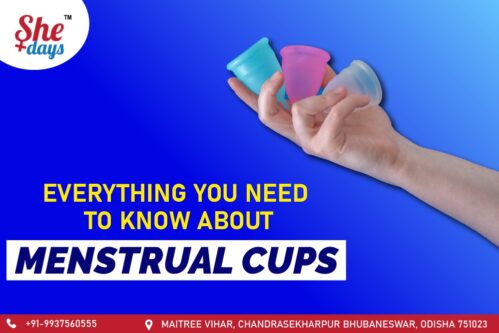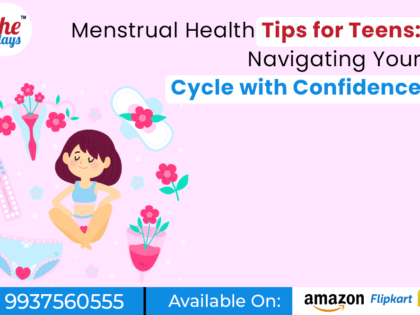Everything You Need to Know About Menstrual Cups
 For a long, we have been using sanitary pads, tampons, and panty liners as they are quite comfortably accessible and most importantly easily disposable- basically, use and throw. However, as we gained our consciousness and moved towards environmentally friendly options, we found out that menstrual cups aka period cups are not only long-lasting, rash-free, and skin-friendly but also affordable as compared to other sanitary products. Nevertheless, many of us are still less aware or we can say are less knowledgeable about this sanitary product, its uses, and its benefits. But no worries because we are here to furnish you with all the know-how by providing you with a detailed guide about everything you need to know about menstrual cups. So without any further ado let us begin by discussing what is a period cup or a menstrual cup?
For a long, we have been using sanitary pads, tampons, and panty liners as they are quite comfortably accessible and most importantly easily disposable- basically, use and throw. However, as we gained our consciousness and moved towards environmentally friendly options, we found out that menstrual cups aka period cups are not only long-lasting, rash-free, and skin-friendly but also affordable as compared to other sanitary products. Nevertheless, many of us are still less aware or we can say are less knowledgeable about this sanitary product, its uses, and its benefits. But no worries because we are here to furnish you with all the know-how by providing you with a detailed guide about everything you need to know about menstrual cups. So without any further ado let us begin by discussing what is a period cup or a menstrual cup?
What is a menstrual cup?
To start describing what is a menstrual cup, in simple terms it is a reusable funnel-shaped cup, a flexible feminine hygiene product that is small in size so that it can be easily inserted into the vagina to contain menstrual blood during period days. It is made of silicone or rubber, can be worn for up to 12 hours (depending on your period flow), and notably, it is eco-friendly. However, if you have not decided yet if you want to switch fully to a menstrual cup but want to give it a try, then you can go for disposable menstrual cups available in the market.
So now you know what a menstrual cup is but how to use a period cup is another important topic to discuss which we will be doing in this article. Continue reading and learn more about how to insert a menstrual cup.
How to wear a menstrual cup?
Menstrual cups or period cups are not hard to find in stores, but the main concern arises when you can not decide which size will be best for you, especially if you are a beginner. Menstrual cups come in sizes ranging from small to large, therefore, to determine your perfect fit you should visit a gynecologist. To select the right cup size for you, the doctor will examine the following:
- Length of your cervix
- Your pelvic floor muscles strength
- Period flow (heavy or light)
- Age
- Cup capacity
- Vaginal delivery or birth
- Flexibility and durability of the cup
All these factors will be considered before deciding the period cup size. Generally, women who have given birth vaginally or have a heavier period flow, or are over 30 years of age, are advised large size period cups. On the other hand, younger women below 30 years are recommended smaller cup sizes.
Menstrual cups for beginners: Suggestion
If you are a first-timer into the menstrual cup world, you might feel discomfort while trying the cup for the first time. This uneasiness is understandable. Thus, before inserting the period cup into your vagina, we would suggest you grease its rim with a lubricant or water for smooth insertion. It will be less discomfiting and painful (for the first try).
Menstrual cup insertion
If you have ever used a tampon, then it will be somewhat easy for you to insert the menstrual cup properly. Carefully follow these steps to make your first experience smooth.
- Your first hygiene step should always be washing your hands thoroughly with soap and water.
- On your menstrual cup’s rim grease some water-based lubricant or simply water to make the insertion painless.
- In one hand, hold the period cup tightly, folding in half, facing upwards.
- Like tampons (without an applicator), slowly insert the cup into your vagina, making it fit a few inches below the cervix.
- Once you feel the cup is in the right position, rotate and release the cup, which will make it spring open, thus creating an airtight seal to stop leakage.
Note: When inserted properly, using a menstrual cup should not hinder your daily chores and normal activities like sitting, moving, jumping, standing, etc. However, if you are still facing some issues with your period, book a doctor’s appointment.
How to remove menstrual cups?
Taking out the menstrual cup is as easy as putting it in. let us see how:
- Again begin by thoroughly washing hands.
- Insert your thumb and index finger into the vagina and gently pull the stem of the cup.
- When you reach the base, pinch it to release the seal.
- Now to remove the cup, pull it down.
- Empty the cup, clean it and follow further aftercare which we will be discussing soon.
How often should you change the menstrual cup?
Depending on the menstrual cup size and your period flow, one can use it for around five to twelve hours. So if you desire, you can use a menstrual cup overnight.
Regardless, do not forget to remove and empty the period cup within 12 hours, or even if it becomes full to avoid leakage.
Care for Cup
So if you are using disposable menstrual cups, then after emptying them, they are to be disposed of and not to be used again. But caring for reusable menstrual cups is necessary as they are durable and pocket-friendly if cared for adequately and can last up to 6 months to 10 years. Therefore, to make it long-lasting and also with the hygiene perspective, do not forget to clean and wipe the period cups before the next reinsertion.
Menstrual cups cost
When it comes to comfort, affordability, and durability as compared to sanitary napkins and tampons, menstrual cups stand strong in all domains. At the least, it will last for around six months (more if taken care of properly) and on average will cost you less.
Menstrual cup pros and cons
Advantages of using menstrual cups:
- Environment friendly
- Pocket friendly
- Can be worn with birth control or an IUD
- Reusable and durable
- No risk of getting a bacterial infection or toxic shock syndrome
- Absorbs more blood than a tampon and sanitary napkin
- No issue while having intercourse as most brands won’t be felt by your partner
Disadvantages of using menstrual cups:
Although cost-effective and reusable, every coin has two sides. We have already seen its pros, so now let us move to its cons.
- If not washed, wiped, and cleaned properly, there are chances you might get a vaginitis
- Some make the mistake of reusing disposable period cups which should not be the case
- Hygiene routine to be maintained
- If you try to insert the menstrual cup without lubrication then it may be a painful experience and may cause further discomfort
- Despite being manufactured of latex-free material, there might be chances that one can be allergic to silicone or rubber
- Finding the right fit could possess be a problem as there is no one-size-fits-all
- Changing a menstrual cup can give you a hard time if you are not in a suitable place as sometimes it turns out to be messy business
- You might also have some problems while getting a hold of the menstrual cup when pulling it out
The Right Hygiene Product for You
Picking the right feminine hygiene product can be overwhelming when there are lots of options available in the market and everyone has their own suggestions and advice for others. But you should always go for one which makes you feel comfy in every situation. Therefore, deciding which product to choose or switching from one to another, ask yourself these questions:
- How budget-friendly is your product?
- During your monthlies do you want to have intercourse?
- The ease of using that sanitary product.
Yet, if you still have any doubts regarding menstrual cups or any other hygiene product and want to see its comparison from a professional viewpoint, get an appointment with your gynaecologist and find out which one works best for you.





